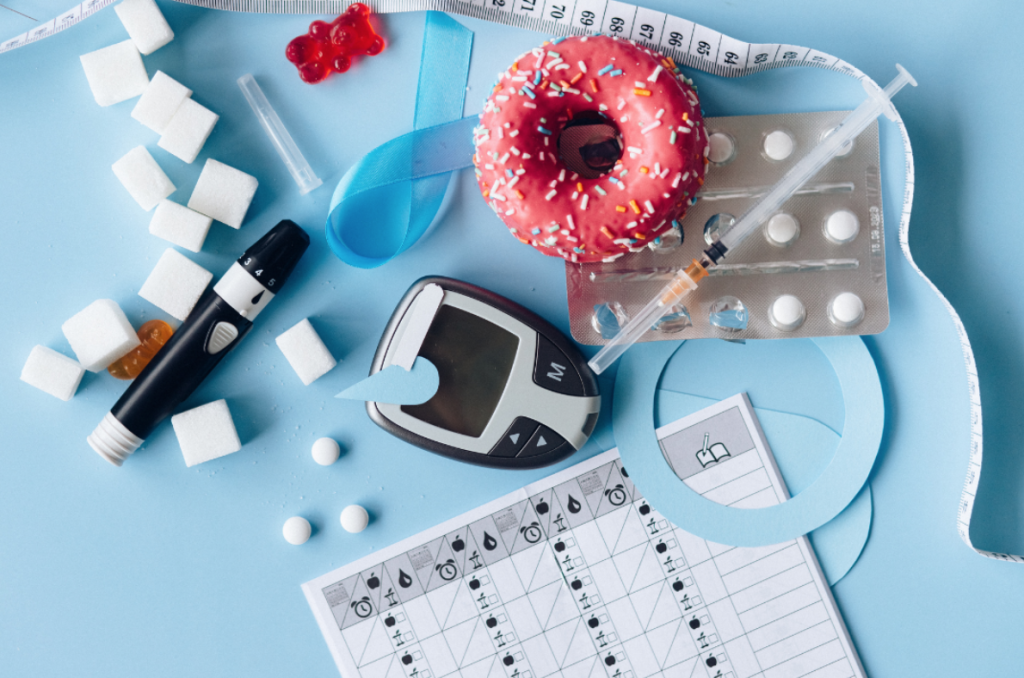Nutrition, Nourish Health Food Pharmacy
Diabetes Awareness: Busting 3 Common Myths
National Diabetes Awareness Week runs from the 10th to 16th July, and this year Diabetes Australia is calling on Australians to reconsider how they think about diabetes. Many people living with diabetes have experienced blame and shame due to the misconceptions around diabetes, and as a result have experienced mental health challenges.
Let’s educate ourselves on diabetes, so we can reduce the burden, blame and barriers for those living with it. This blog busts 3 of the main myths we hear about diabetes, and explains the evidence a bit further.
Firstly, what is diabetes?
Diabetes is a complex condition, but put simply it is an impairment to the way that the body regulates and uses glucose (sugars) as energy. In an individual without diabetes, a hormone called insulin is secreted by the pancreas to move glucose out of the blood and to the muscles and liver for storage. For one reason or another, the pancreas in people with diabetes produces either little or no insulin, and therefore the glucose remains in the blood causing blood sugar highs and lows that come with a variety of symptoms.

MYTH 1: All types of diabetes are the same
FACT: There are different types of diabetes but 3 types that are most common. Each of these are caused by different factors, and can be managed in different ways.
Type 1 diabetes is less common, and is estimating to account for just 5-10% of diagnosed cases. Type 1 is a result of the pancreas completely losing its ability to create the hormone insulin. Type 1 is an autoimmune disorder and is not a result of an individual’s lifestyle or dietary choices.
Type 2 diabetes is the most prevalent type, accounting for 90-95% of diagnosed cases. Type 2 occurs when the body builds up a resistance to insulin and gradually loses it’s ability to produce sufficient quantities. Whilst there is no one factor that causes type 2 diabetes, there are multiple risk factors that can increase the likelihood. Some of these factors include:
- Being overweight or obese
- Physical inactivity
- Smoking
- High alcohol consumption
- Poor diet
- Family history and genetics
The third type is called gestational diabetes. Around 3-8% of women who were not diabetic when entering pregnancy, will develop gestational diabetes during pregnancy. This usually develops in the second half of pregnancy and most healthy women will return to non-diabetic afterwards. However, it can increase your likelihood of developing type 2 diabetes later in life.
MYTH 2: Diabetes is caused by eating too much sugar
FACT: There is not one singular cause of diabetes, but instead a multitude of factors that may increase the risk. The cause of type 1 diabetes is still unknown, however it is thought to be caused by a combination of genetic and environmental factors that may trigger the disease. Diet and lifestyle influences have no role in the development of type 1 diabetes, therefore high sugar consumption does not play a role.
It is also not true to say that sugar consumption directly causes type 2 diabetes. Whilst high sugar consumption over time is one risk factor that may lead to type 2 diabetes, there are many other well established risk factors that also play a role. Scientists believe the development of type 2 diabetes is also largely influenced by family history and genetics. Usually it is a combination of genetics and lifestyle factors that can cause it to develop.

MYTH 3: People with diabetes can’t eat sugary foods
FACT: People with diabetes CAN eat sugar, they just need to do so a little differently. Eating chocolate, lollies, and other sweet foods in moderation is okay, just as it is for any of us, but it is always recommended to do so as part of a healthy diet. Eating too many of these sugary foods can make it difficult to control blood sugar levels, so keeping them to every so often instead of everyday is recommended.
Knowing what foods to eat and how to manage diabetes correctly can be confusing, and that is why working with a qualified Nutritionist or Dietitian can be extremely empowering and helpful for someone who is unsure what they can and can’t eat after a diagnosis. You can book in to see our Nutritionist here.
In summary
Diabetes is a complex condition affecting around 1.2 million Australians. Unfortunately there are many misconceptions circulated about diabetes and those living with it, which is why this year Diabetes Australia’s campaign Heads Up on Diabetes aims to reduce the stigma, increase awareness and educate the population.
If you or someone you know is struggling with what to eat or how to manage a diabetes diagnosis, it is recommended to see a health professional such as a Nutritionist to educate yourself and understand the measures you can take to continue living a healthy life.



